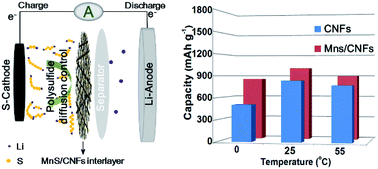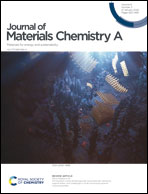Electrospun carbon nanofibers with MnS sulfiphilic sites as efficient polysulfide barriers for high-performance wide-temperature-range Li–S batteries†
Abstract
Lithium–sulfur (Li–S) batteries have the advantages of high theoretical capacity and energy density, which are considered as promising for future energy storage. Besides, the high gravimetric energy density makes Li–S batteries more suitable as power sources for apparatuses such as high-altitude drones and space vehicles. For these applications, the batteries should have a low self-discharge and a wide temperature range. Herein, we introduce carbon nanofibers with MnS sulfiphilic sites as flexible interlayers into Li–S batteries, reducing the shuttle effect and accelerating the reaction kinetics through physical inhibition, chemical adsorption and conversion that promote synergy. The self-discharge of the cell is significantly weakened. The voltage is maintained at 2.37 V during 150 hours resting after 20 cycles. For a sulfur loading of 2 mg cm−2, the capacity is as high as 714 mA h g−1 after 400 cycles at 1C at room temperature. Besides, the operating temperature of the cell is broadened. At 55 °C and 0 °C, the capacity can be stabilized at 894 mA h g−1 and 853 mA h g−1 after 100 cycles at 0.5C, respectively. This work can gain wide research interest toward lithium–sulfur batteries for applications in extreme environments.



 Please wait while we load your content...
Please wait while we load your content...